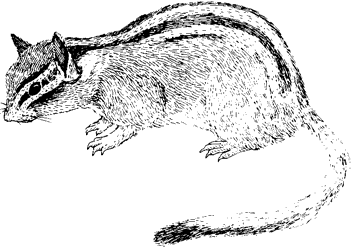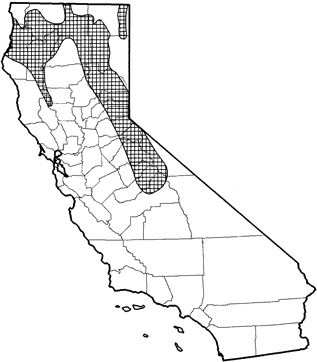
Allen's Chipmunk
Distribution, Abundance, and Seasonality
Occurs commonly in conifer and deciduous forests and brush habitats of the North Coast, Klamath, and Cascade Ranges, the northern Sierra Nevada, and the Warner Mts. from 1000-2750 m (3300-9000 ft) (Storer and Usinger 1963). Prefers dense chaparral and forested areas with substantial shrub understories.

Range Map
Specific Habitat Requirements
Feeding: Allen's chipmunks primarily are herbivorous. They forage on the ground and in litter for seeds of conifers, shrubs and forbs, and fungi. They feed in montane shrub areas adjacent to stands used for cover and reproduction.
Cover: Utilize dense cover of shrubs, logs, stumps. snags, and use burrows for cover.
Reproduction: Allen's chipmunks use nests in trees or snags while raising young.
Water: No data found.
Pattern: Allen's chipmunks use brushy patches in conifer habitats, and edges of rock outcrops, ridges, meadows, and chaparral.
Species Life History
Activity Patterns: Diurnal activity. Become torpid from November through March.
Seasonal Movements / Migration: Non-migratory.
Home Range: In Washington, home ranges of T. townsendii females overlapped very little, suggesting exclusive use (Meredith 1972). Home ranges in Oregon varied from 0.5 to 1.0 ha (1.25 to 2.47 ac) (Gashwiler 1965).
Territory: Females probably are territorial (Meredith 1972); home range and territory probably coincide.
Reproduction: Breeding activity occurs from April through July; most births occur in May. Females produce 1 litter per yr of 4-5 young (range 3-6).
Niche: Little information available. Predators of T. senex include foxes, coyotes, weasels, badgers, snakes, and large birds of prey. T. senex ecological requirements probably similar to T. panamintinus (Johnson 1943). Formerly considered a race of T. townsendii (Sutton and Nadler 1974).
Sources & References
California Department of Fish and Game, 1999.
California's Wildlife, Sacramento, CA.
Written by: T. Harvey, C. Polite, reviewed by: M. White, edited by: M. White, C. Polite
Gashwiler, J. S. 1965. Longevity and home range of a Townsend chipmunk. J. Mammal. 46:693. Ingles, L. G. 1965. Mammals of the Pacific states. Stanford Univ. Press, Stanford, CA. 506pp. Johnson, D. H. 1943. Systematic review of the chipmunks (genus Eutamias) of California. Univ. Calif. Publ. Zool. 48:63-143. Meredith, D. H. 1972. Subalpine cover association of Eutamias amoenus and Eutamias townsendii in the Washington Cascades. Amer. Midl. Nat. 88:102-114. Storer, T. I., and R. L. Usinger. 1963. Sierra Nevada natural history. Univ. California Press, Berkeley. 374pp. Sutton, D. A., and C. F. Nadler. 1974. Systematic revision of three Townsend chipmunks (Eutamias townsendii). Southwest Nat. 19:199-211. Tevis, L., Jr. 1956. Responses of small mammal populations to logging of douglas-fir. J. Mammal. 37:189-196.
California Animal Facts | California's Wildlife